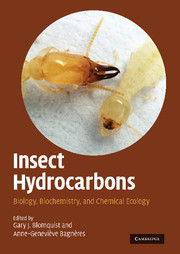Book contents
- Frontmatter
- Contents
- List of contributors
- Foreword
- Acknowledgments
- Part I Chemistry, Biochemistry, and Physiology
- Part II Chemical Communication
- 10 Perception and olfaction of cuticular compounds
- 11 Nestmate recognition in social insects and the role of hydrocarbons
- 12 Cuticular hydrocarbon cues in the formation and maintenance of insect social groups
- 13 Hydrocarbon profiles indicate fertility and dominance status in ant, bee, and wasp colonies
- 14 Chemical deception/mimicry using cuticular hydrocarbons
- 15 Behavioral and evolutionary roles of cuticular hydrocarbons in Diptera
- 16 Contact recognition pheromones in spiders and scorpions
- 17 Hydrocarbons as contact pheromones of longhorned beetles (Coleoptera: Cerambycidae)
- 18 Polyene hydrocarbons, epoxides, and related compounds as components of lepidopteran pheromone blends
- 19 Volatile hydrocarbon pheromones from beetles
- 20 Future directions in hydrocarbon research
- Index
16 - Contact recognition pheromones in spiders and scorpions
from Part II - Chemical Communication
Published online by Cambridge University Press: 18 May 2010
- Frontmatter
- Contents
- List of contributors
- Foreword
- Acknowledgments
- Part I Chemistry, Biochemistry, and Physiology
- Part II Chemical Communication
- 10 Perception and olfaction of cuticular compounds
- 11 Nestmate recognition in social insects and the role of hydrocarbons
- 12 Cuticular hydrocarbon cues in the formation and maintenance of insect social groups
- 13 Hydrocarbon profiles indicate fertility and dominance status in ant, bee, and wasp colonies
- 14 Chemical deception/mimicry using cuticular hydrocarbons
- 15 Behavioral and evolutionary roles of cuticular hydrocarbons in Diptera
- 16 Contact recognition pheromones in spiders and scorpions
- 17 Hydrocarbons as contact pheromones of longhorned beetles (Coleoptera: Cerambycidae)
- 18 Polyene hydrocarbons, epoxides, and related compounds as components of lepidopteran pheromone blends
- 19 Volatile hydrocarbon pheromones from beetles
- 20 Future directions in hydrocarbon research
- Index
Summary
Most of the present book is dedicated to one class of Arthropoda, the Insecta, because chemical communication research in this class is the most complete and broadly illustrated. This type of research on the chelicerate arthropods of the class Arachnida is, by contrast, poorly developed. We saw for example in Chapter 7, studies of chemical ecology interactions with Acari and particularly mite–insect interactions, and a few examples of chemical interaction with spiders were also shown in the same chapter on chemical mimicry, even though spiders are the most familiar and numerous of the arachnids. We undertook some work and about 15–10 years ago on contact chemical signal description and its relationship with behavior, physiology and reproduction, in different types of Aranea (spiders). We will present here a distillation of this work with a review of studies on the subject by different authors. Most notable here is the poverty of research on contact recognition signals and relative behavioral works on the order Scorpionida, the scorpions. Some of the few chemical data available are published here for the first time.
Contact recognition pheromones in spiders
Spiders are generally known as solitary predators with strong territorial behavior. Territory defense often leads to cannibalism, even when male spiders are displaying courtship behavior to females. However interactions between solitary spiders are not always aggressive and conspecifics may interact peacefully during reproduction. Reproductive behavior refers to the set of behaviors that allows the perpetuation of the species: sexual behavior and parental behavior.
- Type
- Chapter
- Information
- Insect HydrocarbonsBiology, Biochemistry, and Chemical Ecology, pp. 344 - 374Publisher: Cambridge University PressPrint publication year: 2010
- 20
- Cited by



